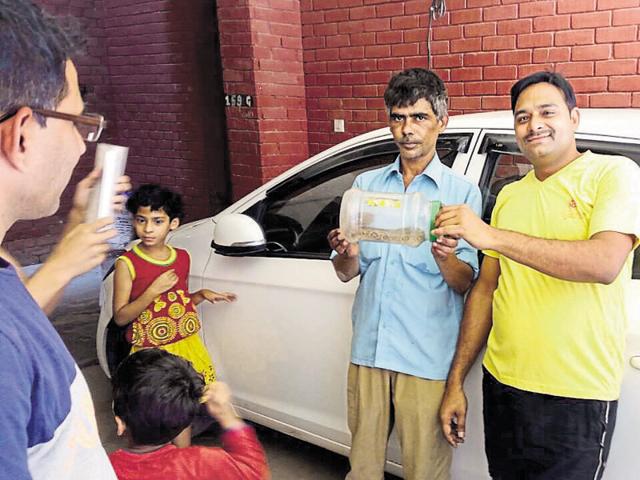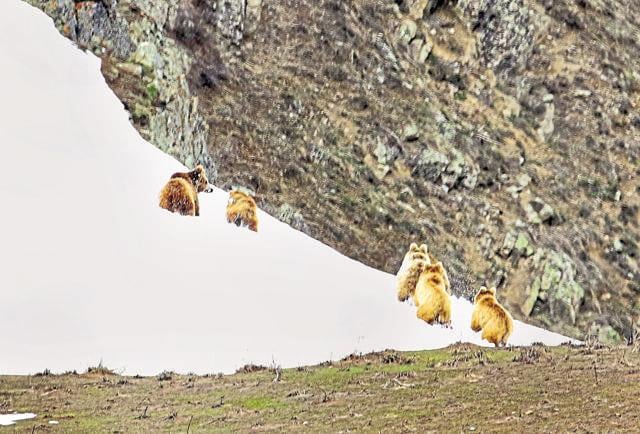Wild buzz: Water didn’t work on this car viper
When Ashok Bishnoi eased his Hyundai i20 hatchback next to a tree in the Sukhna lake parking lot (opposite the Lake Club) on May 11 at 5.30pm, he thought he had found a shady niche.
When Ashok Bishnoi eased his Hyundai i20 hatchback next to a tree in the Sukhna lake parking lot (opposite the Lake Club) on May 11 at 5.30pm, he thought he had found a shady niche. After spending three hours at the Sukhna on a family jaunt, Bishnoi , sales manager with a pharmaceutical company, drove back to his house at Chandigarh Apartments, Barwala road, Dera Bassi. The next morning, Bishnoi discovered a snake in the front alloy wheel. On being prodded, the wriggler retreated into the engine. It was a highly-venomous Russell’s viper, which had stowed in Bishnoi’s car by creeping into the undercarriage while it was parked at the Sukhna. The lake area abounds in vipers due to adjoining jungle and a complex of hedges encircling the cafeteria patio.

A rattled Bishnoi took the car to a service station and had it washed inside-out with a pressure hose to dislocate the viper. He drove back home, raised the bonnet and found the viper curled calmly on the battery fuses. Bishnoi banged down the bonnet hurriedly. The viper vanished into engine’s depths and emitted pressure-cooker-like hisses. At his wits’ end, Bishnoi on May 13 summoned snake catcher Salim Khan, who advised him to park the car (windows up) in the sun for four-to-five hours so that the heat build-up forced the snake out of the engine’s labyrinth. However, there was no sign of the wily viper. The car was taken to the service station and hosed again. Khan went between the ramp and examined the undercarriage with a flashlight. No sign, no hiss.
On May 15, Bishnoi, while checking his engine for the nth time, saw the viper on the battery. Khan was summoned, and this time he discovered the viper’s bunker: a cavity under the battery where it would coil tightly like a ‘jalebi’. The viper was at last — after five nerve-racking days — evicted successfully. “The viper made us nervous, for it could have entered the passenger area and crawled over our feet while driving. I refrained from driving the car on some occasions,” confessed Bishnoi.
Yeh hill maange sher

If you can imagine Diwali fireworks on an atomic test scale every few nights at Drass, you will have grasped adequately the devastation and display of the “crunch” delivered by massed artillery on Pakistani intrusions in June 1999. This writer from a vantage point at the 56 Mountain Brigade headquarters witnessed the lining up of 120 artillery guns on the Drass axis, including a preponderance of Bofors, and the “direct fire” of 800 shells in 45 minutes. The Pakistani sangers (bunkers made by piling rocks) were pulped and the ridges aflame with explosion. Our infantry would brace, and then race up slopes to evict the concussed Northern Light Infantry.
Well, Tiger Hill was a favoured habitat of the Himalayan Brown bear. But the Kargil War, and the artillery duels that preceded it from 1998 onwards, rendered the Drass heights inhospitable. This writer went up the Tololing Nullah into the battle zone at 16,000 feet in June 1999 with 18 Garhwal Rifles and discerned not a trace of bird or beast on those warring heights. Only tiny yellow and blue wild blooms remained, bearing in silence the booms and the invasion of humans engaged in mutually assured destruction.
The good news is that the ceasefire held firm and wildlife has flourished. “I have seen larks in the battle zone and raptors such as Lammergeiers, Griffon vultures, Golden eagle, Peregrine falcon and Common kestrel. Breeding bears have been photographed, including one group with three sows and five cubs, residing in ridges west and parallel to Tiger Hill. The bears were always there but war displaced them and impaired breeding,” Kargil wildlife warden Intesar Suhail told this writer.
The bad news is that bears come down to army camps at night to scavenge on kitchen remains. The Captain (Vikram) Batra Transit Camp is one of the many sporting warning sign ‘Beware of wild bears’. Easy and assured kitchen food not only distracts bears from their natural habitat, prey, and scavenging sources above the tree line but also pitches them into deadly conflict with locals, whose livestock they ravage.
Pests making love

Nature kindles an interest in most of us, may it be a spark or a specialisation. Mobile-phone cameras fitted with quality optics and touch-speed shutter have enabled the capturing of delightful moments by casual observers, who were fortuitous enough to be at the right place at the right time. Retired Punjab IAS officer and former Chandigarh Golf Club president Gurinderjit Singh Sandhu clicked Lime butterflies in one such rainbow moment of marital fusion. Their bed of bliss was a Hamlin plant in his orchard near Payal in Ludhiana district.
The Lime butterfly is officially a declared pest on citrus-fruit plants, since it lays eggs on the underside of leaves and the larvae feed on these as voraciously as country bumpkins might overtax a hapless host. The Hamlin or sweet orange is a hybrid of the ‘mausami and malta’ and Sandhu’s plants were imports from the US. However, Sandhu says butterflies are not the worst sources of destruction “in his orchard”, as other pests such as citrus pyslla and aphids pose a greater hazard. “I am trying hard to lose money on agriculture but my plants and their winged denizens afford me much joy and peace,” quips Sandhu with a merry twinkle in his eye.
vjswild1@gmail.com



